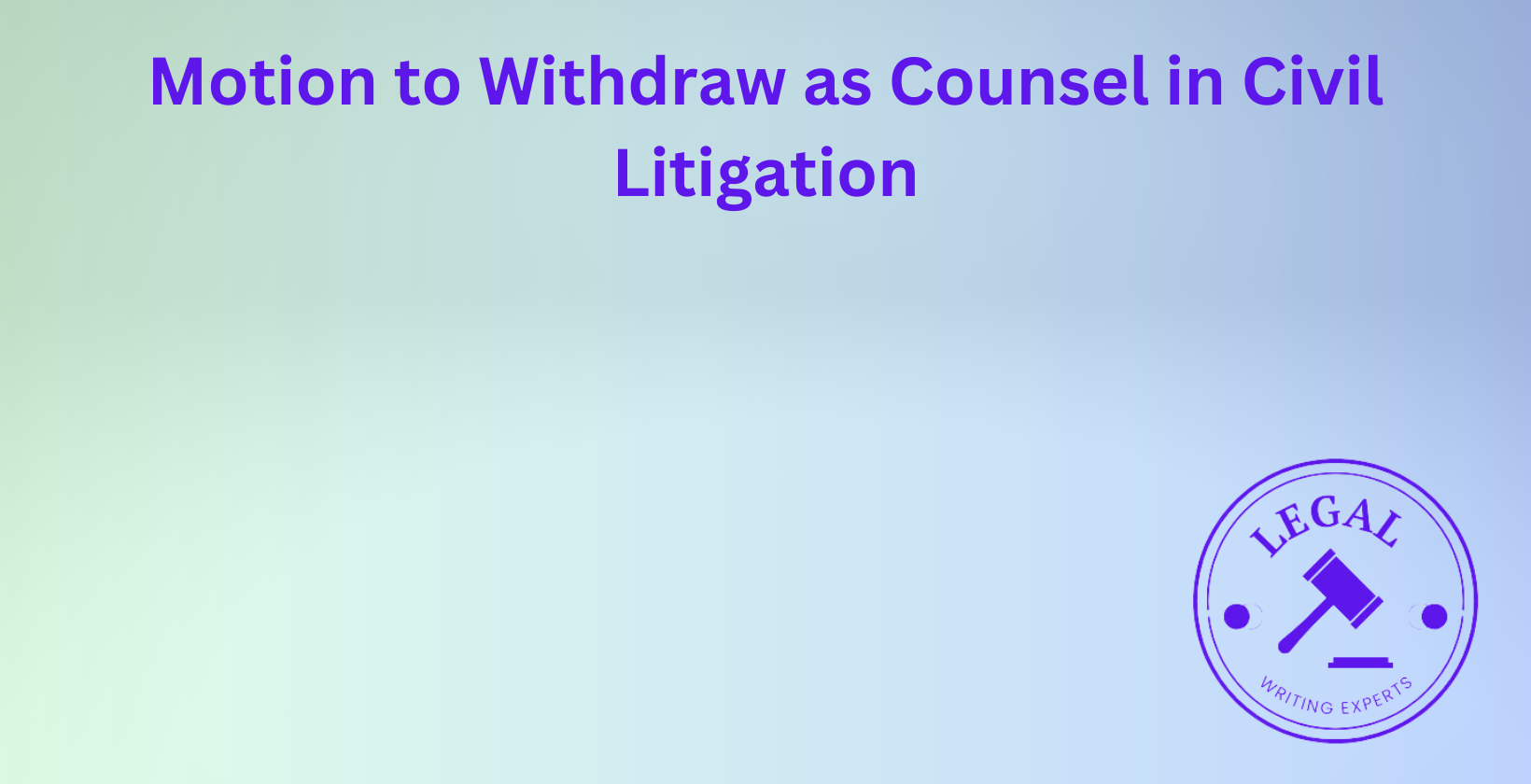Motion to Withdraw as Counsel in Civil Litigation
Written by
Jessica E
February 21, 2025 · 8 min read

A motion to withdraw as counsel in civil litigation is a formal request filed by an attorney seeking to terminate their representation of a client in a lawsuit. This legal procedure requires adherence to court rules and ethical obligations. Attorneys may seek withdrawal due to conflicts of interest, non-payment of fees, or client misconduct. Clients affected by withdrawal must secure new representation or proceed pro se. Courts evaluate withdrawal motions based on procedural compliance, case status, and potential prejudice to the client. Understanding the withdrawal process ensures that attorneys and clients navigate the legal system effectively.
What Is a Motion to Withdraw as Counsel in Civil Litigation?
A motion to withdraw as counsel in civil litigation is a formal request submitted to the court by an attorney seeking to terminate their legal representation of a client in an ongoing case. Attorneys must obtain court approval before ceasing representation to ensure that withdrawal does not disrupt the judicial process. Courts consider several factors when ruling on these motions, including the case’s procedural posture, the reason for withdrawal, and the potential impact on the client’s ability to proceed with the case.
When Is It Appropriate for an Attorney to Withdraw from a Civil Case?
An attorney can withdraw from a civil case when specific conditions justify termination of representation. The court may grant withdrawal if continuing representation violates ethical rules, if the client refuses to fulfill obligations, or if irreconcilable differences arise. Attorneys must demonstrate that their request aligns with legal standards and does not unduly harm the client’s position. The timing of withdrawal is critical, as courts are more likely to approve the motion when it does not delay proceedings or prejudice the client’s case.
What Are the Common Reasons Attorneys Withdraw from Representation?
Attorneys withdraw from representation for various reasons, including non-payment of legal fees, conflicts of interest, and breakdowns in attorney-client communication. Ethical conflicts arise when continued representation would require an attorney to act against professional obligations. If a client fails to cooperate, withholds critical information, or engages in fraudulent activities, an attorney may seek withdrawal to maintain ethical integrity. Health issues, personal matters, or changes in legal practice may also necessitate withdrawal. Courts assess whether the stated reason justifies termination of representation before granting the motion.
How Does an Attorney File a Motion to Withdraw as Counsel?
An attorney files a motion to withdraw as counsel by submitting a formal document to the court outlining the reasons for withdrawal. The motion must comply with local court rules and include proper notice to the client and opposing counsel. In most cases, attorneys must provide sufficient time for the client to find new representation. Some jurisdictions require attorneys to include a proposed order for the judge’s approval. Once the motion is filed, the court schedules a hearing or reviews the submission before making a ruling.
What Information Should Be Included in a Motion to Withdraw?
A motion to withdraw should include the attorney’s name, the client’s name, the case details, and a statement explaining the grounds for withdrawal. The document must specify whether the client consents to or opposes the withdrawal. Courts often require attorneys to confirm that they have informed the client of pending deadlines and procedural obligations. Confidentiality rules limit the extent of detail attorneys can disclose, particularly if withdrawal is due to conflicts or ethical concerns. Some motions must include an affidavit affirming that the attorney has taken reasonable steps to mitigate any adverse impact on the client.
What Are the Ethical Considerations for Attorneys Seeking Withdrawal?
Attorneys seeking withdrawal must adhere to ethical obligations under professional conduct rules. The duty of loyalty requires attorneys to avoid actions that could harm the client’s interests. The duty of confidentiality prevents attorneys from disclosing privileged information when explaining their reasons for withdrawal. Courts expect attorneys to provide reasonable notice to the client and ensure they have time to secure new representation. Withdrawal should not leave the client unrepresented at a critical stage of the case unless circumstances make continued representation untenable.
How Can Clients Respond to Their Attorney’s Motion to Withdraw?
Clients can respond to their attorney’s motion to withdraw by consenting or objecting to the request. If a client agrees to the withdrawal, they may submit a statement of non-opposition. If a client objects, they must file a formal opposition outlining the reasons for their objection. Courts consider whether the withdrawal would leave the client unrepresented at a crucial point in the case. Judges may deny a withdrawal motion if they determine that granting it would severely prejudice the client’s legal standing.
What Are the Potential Implications for Clients When Their Attorney Withdraws?
Clients face multiple challenges when their attorney withdraws from representation. Withdrawal can delay proceedings, increase legal costs, and require clients to find new legal counsel quickly. Clients who cannot afford new representation may have to proceed pro se, which can negatively affect case outcomes. Courts may impose deadlines for clients to secure new counsel to avoid unnecessary delays. Understanding the withdrawal process enables clients to make informed decisions about how to proceed in their case.
How Can Clients Find a New Attorney After a Withdrawal?
Clients can find a new attorney after a withdrawal by contacting legal referral services, seeking recommendations from bar associations, or using online legal research companies. Many law firms offer consultations to assess case needs and discuss representation terms. Clients should verify an attorney’s credentials, experience, and fee structure before hiring new counsel. Some courts provide lists of legal aid organizations for clients who require assistance securing affordable representation.
What Is the Process for Substituting Counsel in Ongoing Civil Litigation?
The process for substituting counsel in ongoing civil litigation involves filing a substitution of counsel form with the court. Both the outgoing and incoming attorneys must sign the document, confirming the transition of representation. Clients must approve the change unless the court has ordered a substitution. Once the court accepts the filing, the new attorney assumes all legal responsibilities. Substitution ensures continuity in representation without causing delays or procedural complications.
How Can Attorneys Avoid the Need to Withdraw from Representation?
Attorneys can avoid the need to withdraw from representation by maintaining clear communication, setting clear fee arrangements, and managing client expectations. Proper case screening ensures attorneys accept cases within their expertise and resource capacity. Addressing disputes early and documenting all interactions helps mitigate conflicts. Establishing detailed engagement agreements clarifies the scope of representation and prevents misunderstandings that could lead to withdrawal requests.
What Are the Court’s Considerations When Granting or Denying a Motion to Withdraw?
Courts consider multiple factors when deciding whether to grant or deny a motion to withdraw. Judges assess whether withdrawal would cause undue prejudice to the client, delay proceedings, or disrupt the case’s progress. Courts also review whether the attorney has complied with ethical obligations, including providing reasonable notice to the client. If withdrawal would leave a client without representation at a critical stage, courts may deny the motion unless exceptional circumstances exist. Balancing the attorney’s right to withdraw with the client’s right to effective representation is a key judicial consideration.


